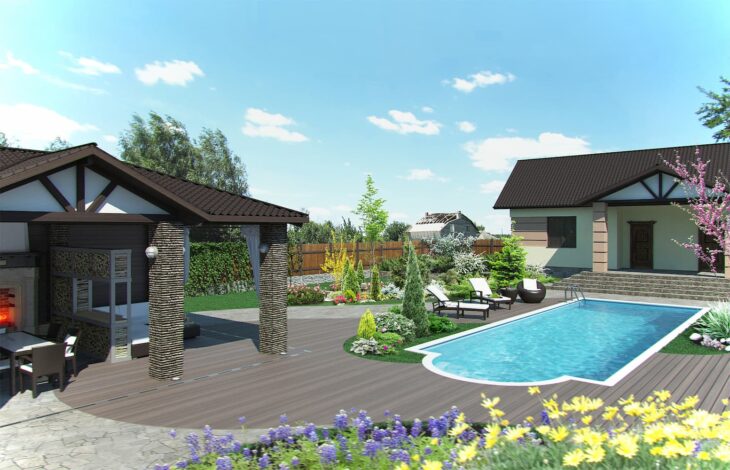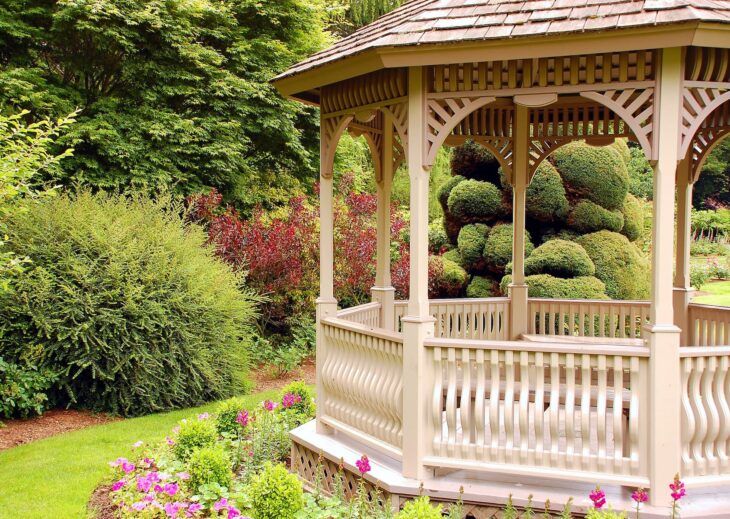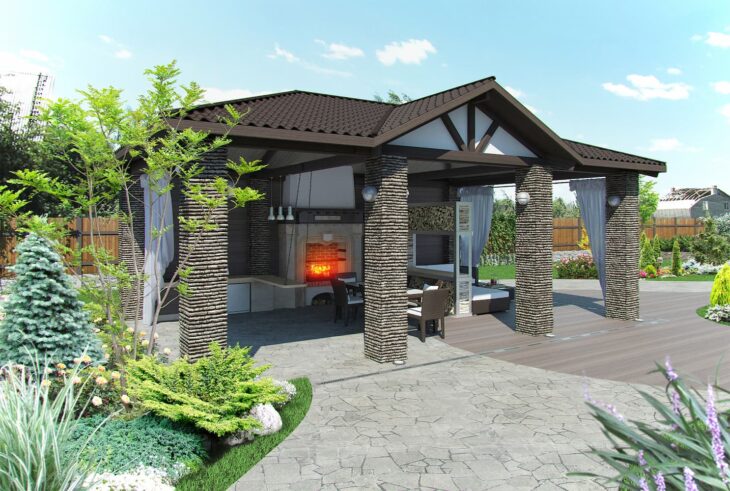Disclosure: Articles may contain affiliate links. As an Amazon Associate, we earn from qualifying purchases (at no additional cost to you). See our full disclosure here.
Last updated on July 24th, 2023 at 02:57 pm
Pavilions have been experiencing a surge in popularity as outdoor structures. Vinyl pavilions, in partciular, are getting lots of attention due to their exceptional durability and minimal upkeep requirements.
When it comes to adding a charming and comfortable space to your backyard, pavilions can be a terrific choice.
But, before you make any decisions when it comes to your next outdoor project, let’s dive into the specifics. There are several important factors you’ll need to consider.

Let’s begin with the basics: what is a pavilion, and how does it differ from a gazebo or a pergola?
A pavilion can be the perfect hangout spot in your backyard, and you’ll often see pavilions in public parks too.
A pavilion is a covered structure, often open on all sides, supported by pillars or columns, and has a solid roof. Think of it as a mini-building, but without walls. Pavilions are perfect for hosting parties, picnics, or just chilling with friends on a sunny day.

A gazebo is similar, but is usually smaller and is often octagonal or circular in shape. Gazebos might be found in gardens and offer a cozy little space to relax and enjoy the outdoors.

A pergola can be thought of as the more laid-back sibling of the pavilion and gazebo. It’s an outdoor structure with vertical posts and crossbeams, but the roof is open, so it’s more about providing a little shade and a cool spot rather than complete coverage.
Pergolas can be good for growing vines and creating a more rustic vibe.
So, in a nutshell, pavilions are like outdoor rooms (minus the walls), gazebos are decorative and cozy, and pergolas have an open roof, but still provide some shade. Each one has its own look and purpose. That means it’s up to you to decide what kind of look and function you want in your outdoor structure.
If you’ve decided to build a pavilion, keep reading for four considerations you’ll need to keep in mind.

Building a Pavilion? Consider…
The Climate
If you’re ready to build a pavilion–or even a porch, or outdoor kitchen, your local climate has to be taken into account.
For example, where I live in the Southeast United States, we have a humid subtropical climate. That means the emphasis needs to be on a design that will provide relief from hot summer temperatures and high humidity.
To create relaxing and comfortable backyard spaces, you’ll not only need to find an attractive and comfortable design–you’ll also want to consider what materials are right for your climate.
In my area, vinyl material is a great choice when building a pavilion or outdoor structure that needs to withstand the weather conditions.
Whatever your climate type, ensure your building material can hold up against harsh summer UV rays, high summer temperatures, as well as rain, and possibly snow (depending on your location).
Building Regulations
Next, be sure you research and understand the local building regulations and know which permits may be needed before you begin building your pavilion or outdoor structure.
These rules and permits differ from city to city, so make sure you reach out to find the correct information. It’s essential to familiarize yourself with zoning laws, setbacks, and any other regulations that could potentially affect the design and construction process of your pavilion.

Design Considerations
When building a pavilion, carefully consider both the visual appeal and practicality of the design.
The ideas is to fit in with the natural surroundings and harmonize with the existing architectural elements (probably your home, in this case), while offering a functional space for whatever activities you want to do.
Since of course, this type of outdoor structure is mostly enjoyed in warm, sunny weather, think about how best to keep things cool.
Shading techniques that can shield against the harsh sun, like overhangs or louvers can be a wonderful addition to your project. And many vinyl pavilions provide their own built-in retractable shading systems, which allow for optimal control over sunlight exposure, privacy, and ventilation.
Maintenance and Longevity
Vinyl pavilions are highly regarded for their exceptional durability and long-lasting qualities. When compared to many other materials, vinyl holds up very well against decay, fading, and pests.
That doesn’t mean vinyl structures don’t need any maintenance though. Regular cleaning is a must if you want to keep your pavilion in good condition.
There are different types of vinyl materials, and each has its own maintenance requirements. Some may need to be cleaned occasionally using mild soap and water, while others may require even less maintenance. Talk to your builder or the pavilion manufacturer to make sure you know how to care for your structure.
Nowadays, you can opt for eco-friendly materials that are high-quality and durable which will greatly increase the longevity of your pavilion, and as a bonus will align with environmentally-responsible practices.
Conclusion
When designing and building a pavilion, it is vital to take into account the aesthetic appeal and functionality of the structure. It should integrate as seamlessly as possible with the surrounding landscape and existing home while providing a comfortable space that meets your family’s needs.
To create a comfortable outdoor environment that can be enjoyed year-round, consider adding overhangs and louvers into your design. Or choose a pavilion with it’s own retractable shading system. These features will not only provide shelter from the elements but also help regulate the temperature in any season.
Speaking of seasons, your climate matters, so be sure to consider this, and choose building materials that will hold up over time. You want your pavilion to last!
And, don’t forget to check out the rules and regulations when it comes to building an outdoor structure in your city–before you get started.
With these tips in mind, your new pavilion project will get off to a smooth start, and you’ll be enjoying your new backyard space before you know it!
Also read:
Create Your Perfect Backyard Kitchen: 7 Things to Consider
Outdoor Style Inspiration: Our Favorite Neutral Patio Decor Pieces
How to Create a Cozy Patio Space: 9 of Our Best Tips
Give Your House a Facelift: 6 Smart Ways to Update the Exterior of Your Home
You can find MomsWhoSave on Facebook, Instagram, Pinterest, and Twitter. Join us for updates!
Leave a Reply